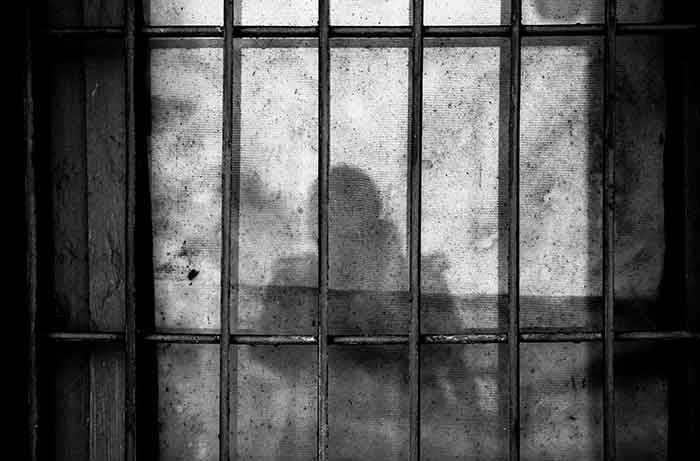
As Covid raged across India over the last two years hundreds of thousands of Indian prisoners suffered the most. Under ‘permanent lockdown’ their voices remained unheard behind the walls of the prison.
According to reports, almost 70 per cent prisoners in Indian prisons are undertrials. The overwhelming majority comprise Muslims, minority communities, adivasis and dalits. However, there are few reports about how many prisoners suffered the onslaught of the pandemic.
A rare account of the situation came recently from Natasha Narwal and Devangana Kalita, JNU research scholars and activists of Pinjda Tor, who were arrested on cooked up charges during the anti-CAA protests in Delhi. After a path-breaking judgement by the Delhi High Court which was endorsed by the Supreme Court, they were finally released on bail. In a jointly penned article in the Indian Express, on January 24, 2022, they have expressed their deep angst and helplessness inside the Tihar jai, especially the suffering and despair prevalent among women prisoners. They have written:
‘‘Aisa lagta hai kabr mein aa gaye hain, na koi awaaz bahar ja sakti hai, na koi awaaz andar aa sakti hai” (It feels like we have entered a grave, no one can hear us and we cannot hear anyone) — a piercing observation made by one of our co-inmates last year, as we lived the deadly second wave of the pandemic inside Tihar’s women’s prison, Jail No.6. With the third wave currently unfolding, urgent attention must be paid to the terrible conditions under which one of the most neglected groups of this country is surviving — India’s prison population…
‘‘The days of incarceration when the second wave was devastating lives outside and inside, its pain and horror, continue to haunt us. Tihar’s women’s prison witnessed a massive spread of the virus. We watched helplessly as cases emerged from one overcrowded ward after another. We mourned the deaths of our co-inmates far away from their homes. We waited in restless dread for the next day’s five-minute phone call for what news it may bear of our loved ones outside. We began to confront the fear of our own deaths inside that wretched place.’’
They have written that once a prisoner was inflicted with the deadly virus, she would be shifted to what was called the “Corona ward”, while the barrack where she shared space with others would become a quarantine for two weeks, 24×7. Prisoners were therefore compelled to live in a state of permanent quarantine and isolation.
‘‘We spent many heart-breaking days and nights listening to the shattering cries of little children when their barrack came to be quarantined… Our barrack mate and co-accused, Gulfisha, suffered high fever, severe head and body ache, sleeplessness and loss of appetite. Identified as ‘symptomatic’, she was put in a tiny suffocating cell with two other inmates. Her Covid was never detected because no RTPCR tests were available — only a limited number of antigen tests were being conducted. Testing kits were in short supply, along with all other equipment such as sanitisers, masks, gloves, PPE suits. Barracks full of symptomatic patients were given a liberal supply of paracetamols, cetirizine, cough syrups and various other drugs through untrained inmates who had to work as paramedics in the absence of a requisite number of trained medical staff…’’
 In its May 2021 issue, the Economic and Political Weekly reports that of the nearly 70 per cent plus undertrials, most are languishing without any legal aid, or family support. ‘‘As per Prison Statistics India Report 2019, there were 4.78 lakh inmates in around 1,300 prisons in the country. Most of these prisoners hail from economically poor backgrounds, with more than 85 per cent from Scheduled Caste, Scheduled Tribe, Other Backward Class and Muslim communities. When the COVID-19 pandemic struck last year, COVID-19 positive cases in prisons became a cause for worry.
In its May 2021 issue, the Economic and Political Weekly reports that of the nearly 70 per cent plus undertrials, most are languishing without any legal aid, or family support. ‘‘As per Prison Statistics India Report 2019, there were 4.78 lakh inmates in around 1,300 prisons in the country. Most of these prisoners hail from economically poor backgrounds, with more than 85 per cent from Scheduled Caste, Scheduled Tribe, Other Backward Class and Muslim communities. When the COVID-19 pandemic struck last year, COVID-19 positive cases in prisons became a cause for worry.
In March 2020, the Supreme Court took suo moto notice of the situation in the prisons and passed several significant orders, which led to the constitution of high-powered committees (HPCs) at the state level, headed by the chairperson of the State Legal Services Authority, to decide on categories of prisoners who could be released on temporary bail and parole to reduce overcrowding of prisons. It also passed orders for the Under Trial Review Committees headed by a district judge to meet every week to identify undertrials who could be released on bail or personal recognisance bond, as per criteria in a standard operating procedure (SOP) issued by the National Legal Services Authority (NALSA)…’’
A former Director General of Prisons of Tihar and other jails in Delhi told Covid Response Watch that though the condition in the Delhi jails, especially in Tihar, are much better than many other prisons in India, the Covid scenario must be tough on the prisoners. Consequently, according to him, several prisoners were given bail or parole. Many of them availed it and returned back to prison displaying good conduct, but many of them indulged in criminal activities again, thereby setting a bad record.
Indeed, with no family support or economic structure to fall back upon, many prisoners choose to remain in prisons, even when they can get bail. This too is a major dilemma in the Indian prison system. Marginalised, jobless and poverty-stricken, they carry the stigma and baggage of their past and are simply not able to adjust in the society, even if they are at all accepted.
Besides, they work inside prisons, earn a small livelihood, and get food and shelter, which is well-nigh impossible outside the prison. That is why perhaps they choose the overcrowded, congested and unhygienic state of living inside the prison, cut off from their family, friends, and communities. This is at once a tragic and predictable phenomenon among prisoners in many Indian prisons.
Amit Sengupta is Executive Editor, Hardnews and a columnist, currently based in Kolkata













































